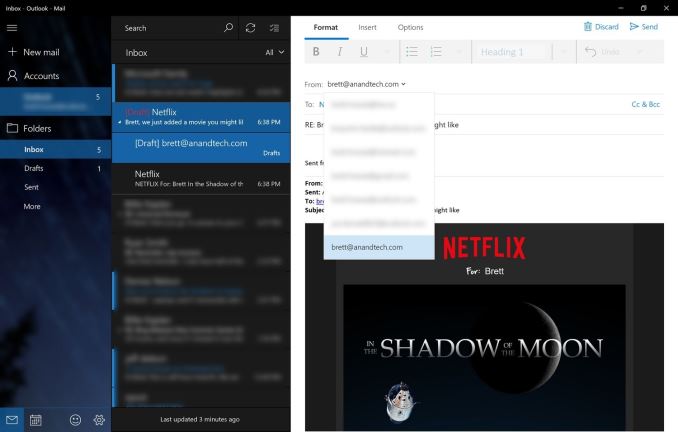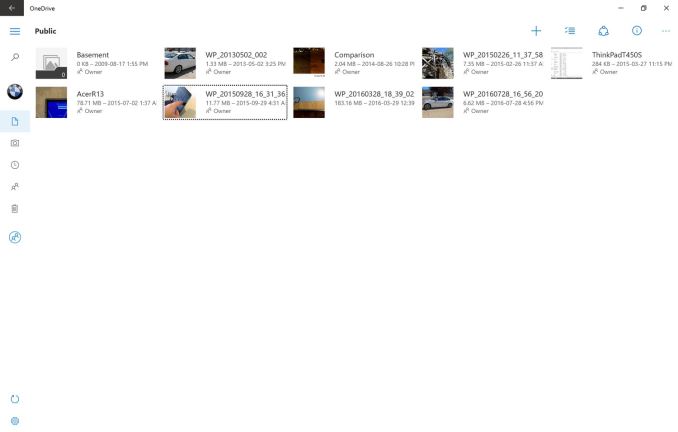Windows 10 Anniversary Update: The Road To Redstone
by Brett Howse on August 2, 2016 8:00 AM EST- Posted in
- Operating Systems
- Microsoft
- Windows 10
New Features And Built-In App Updates
Dark Mode
The Anniversary Update also adds another feature to personalize the experience: Dark Mode. As the name suggests, Dark Mode changes the default color scheme to black. The built-in apps also set their color scheme based on this setting, including mail, the store, and more.
This is certainly a nice feature for personalization, but it’s also a smart idea with recent launches of PCs and tablets with OLED displays. Lenovo showed off their own theme for Windows 10 at CES, for use with their OLED laptops, which eliminates a lot of the bright white display aspects that desktops and laptops have become accustomed to.
Other apps, such as Edge, also include a dark mode but the toggle is in the app settings, so you can customize this the way you prefer.
Mail App
The built-in Mail app hasn’t changed much visually since it was launched, but it’s continued to gain features which were very much missing when the OS first shipped. For instance, the mail client originally shipped with Conversation View as the only way to see your mail. About a month after Windows 10 shipped, an update arrived which allowed you to set the view to the more traditional view of chronological order.
With the Anniversary Update, Microsoft has finally fixed another missing feature which was a huge inconvenience for many people (myself included) which is you can finally send mail as another address. The Windows 8.1 mail client supports this, Microsoft’s Outlook.com supports this, but until this update, the Windows 10 mail client was missing this. You could of course put multiple accounts into it, but if you’ve consolidated to one, you can now use a drop-down selection on the send address to pick any addresses configured.
OneDrive
The OneDrive experience changed dramatically with Windows 10. Windows 8.1 featured the ability to see all of your files in OneDrive, and only download those that you wanted to access. Windows 10 ditched that and went with a per-folder sync when OneDrive was configured. With the limited storage on many devices, this wasn’t always ideal. To compound matters, there was no app for OneDrive when the OS launched.
At least one of these issues is now gone, and while not tied to the Anniversary Update, there is now an app to access OneDrive. It does give access, and you can download files that you need, although it’s a traditional file-save dialog rather than just download it and keep the file in sync within the OneDrive folder like in Windows 8.1.
There were reports of placeholders coming back to Windows 10, but at least so far, there hasn’t been any official word of this feature coming back. Until a new solution is found, OneDrive is not be the integrated experience it was in Windows 8.1.













194 Comments
View All Comments
Michael Bay - Tuesday, August 2, 2016 - link
Chrome is a bloated hog everywhere. Memory/battery/whatever.secretmanofagent - Tuesday, August 2, 2016 - link
Definitely is for OS X. CPU sometimes goes crazy and have to kill tabs.powerarmour - Tuesday, August 2, 2016 - link
Prove me wrong, or STFU.Michael Bay - Wednesday, August 3, 2016 - link
Countless user experiences prove you wrong every day.But keep hurtin`, please, it`s entertaining to watch.
powerarmour - Wednesday, August 3, 2016 - link
How old are you, 12?Get a Chromebook, see how long the battery lasts.
Chrome is such a bloated hog when it runs fine on 2GB RAM and lasts 10+ hours...
BurntMyBacon - Wednesday, August 3, 2016 - link
Or I could, you know, stick with the devices I have and not spend money I don't need to spend on a device I don't want and simply use a browser that works better for my needs.BurntMyBacon - Wednesday, August 3, 2016 - link
@powerarmour: "Prove me wrong, or STFU."You realize he could say the same to you. While I generally don't agree with such all inclusive statements as "Chrome is a bloated hog everywhere", there are more than a few places on the internet that suggest this is the case in a fairly extensive number of popular ecosystems.
My personal experience is that chrome has a detrimental effect on the battery life of several generations of Asus gaming laptops (Win7 / Win8 / Win10), a 2-in-1 (Win10), two android tablets (Asus - Kitkat / nVidia - Marshmallow), an android phone (Samsung - Lollipop), and a Macbook Pro (Yosemite / El Capitan). I will take your word that it is less of an issue in a chromebook. However, I have no desire to purchase one and I have no friends from whom I can borrow one to try it out.
nikon133 - Tuesday, August 2, 2016 - link
I'd say that's purely a Google thing. Considering that Windows is still their major desktop/laptop platform, they should put more effort in Windows version of Chrome...powerarmour - Tuesday, August 2, 2016 - link
Windows isn't Google's major desktop/laptop platform though is it?, it's Linux and Android.They come first, and that's primarily what it's optimized for. Seriously ChromeOS/Chromium has no major issues with battery life otherwise Chromebooks wouldn't be lasting up to 12 hours...
Gigaplex - Tuesday, August 2, 2016 - link
Chromebooks usually have quite different hardware configurations to conventional laptops. Comparing battery life of a single application is not apples to apples.